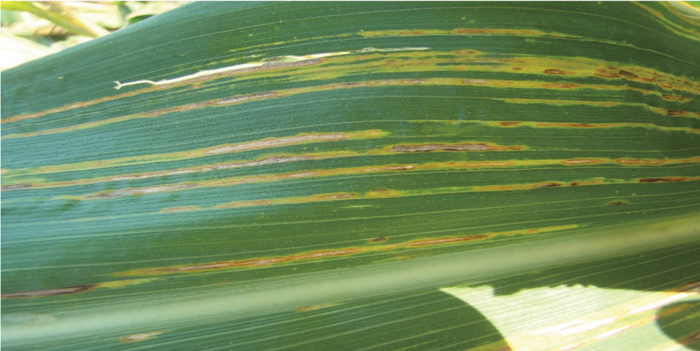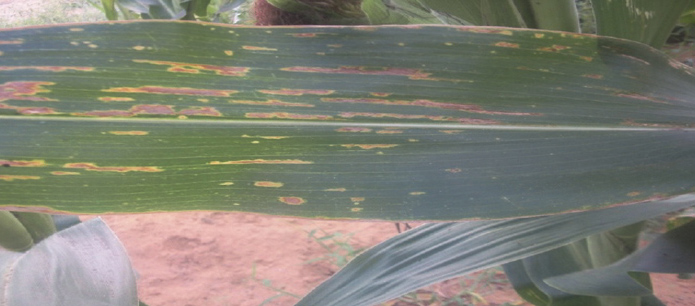
ARC-Grain Crops, Potchefstroom
 Dr Henry Njom,
Dr Henry Njom, ARC-Grain Crops,
Potchefstroom
The pathogen causing bacterial leaf streak (BLS) is Xanthomonas campestris pv zeae, which was first reported in South Africa in 1949. To date maize is the only reported host of this pathogen which was until recently only recorded to occur in South Africa.
Initial work was carried out by Dr Molapo Qhobela during his PhD studies at Kansas State University under the guidance of Dr Larry Claflin. During this study he worked on the identification of the pathogen. More recently Dr Teresa Coutino and Dr Mike Wallis at the University of KwaZulu-Natal screened genotypes for resistance to BLS.
Recently two students at North West University in Potchefstroom completed work on their master’s degrees on this disease under the guidance of Prof Carlos Bezuidenhout and Dr Bradley Flett. These studies focussed on the correct identification, inoculation techniques, pathogenicity, protein profiling, molecular characterisation and the incidence and severity of the disease during the 2011/2012 and the 2012/2013 epidemics in the northern Free State, the North West Province and southern Gauteng.
Until 2016 BLS was only found in South Africa, hence the paucity of literature on the disease. However, in 2016 it was reported in the corn belt of the United States of America (USA) in Nebraska and has since been confirmed in Colorado, Illinois, Iowa and Kansas. Since its appearance in the USA, further interest in this disease has led to more researchers working on various aspects as well as possible control measures.
It has since seemingly disappeared, even though local scientists were on the lookout for isolates to compare to the isolates found in the USA. Suddenly this season (2020/2021), samples were sent to the ARC-Grain Crops for identification from the Dirkiesdorp/Piet Retief area. The sporadic and seasonal recurrence of this disease is due to favourable climatic conditions, but it nevertheless requires basic research such as genotype screening, epidemiology studies related to favourable climatic conditions, alternate host crops, whether the pathogen is seed borne or not, yield losses and isolate variation. This information should give adequate background information on which an integrated disease management system can be developed.
Disease symptoms
Symptoms on maize plants can be observed at all plant growth stages, but are most severe after flowering. Initial symptoms appear as dark streaks on the leaves. These enlarge to form narrow, yellow streaks which begin to show necrotic lesions within the lesion (Photo 1). Streaks can be 2 mm to 3 mm wide and vary greatly in length. These lesions reduce the photosynthetic ability of the leaves, which inevitably results in yield losses. Leaves with lesions can be taken in to the laboratory, dissected across the lesion and placed on a water droplet. A typical bacterial ooze will be observed, spreading out of the lesion into the water droplet. This bacterial ooze is what differentiates BLS from lesions of grey leaf spot (a fungus) and severe sunburn of the leaf which are often confused in field identifications of these three diseases.
Producers who are not certain of a diagnosis, can send samples to the authors at the plant pathology section at ARC-Grain Crops in Potchefstroom. Erroneously spraying because of an incorrect diagnosis can have costly consequences. In the case of badly infected leaves where BLS lesions may extend across the leaf veins and form large necrotic areas, which can shred and become tattered under windy conditions, up to 40% of a maize plant’s leaves can brown and dry prematurely.


Epidemiology
The pathogen biology and disease epidemiology have not been studied enough to be well understood. Its potential impact on yield is not known in commercially available hybrids. The pathogen survives in infected maize stubble from previous seasons and is thought to infect the next maize crop’s plants through natural openings in the leaves. These initial infections can be seen on maize seedlings under optimum climatic conditions. Secondary infections may be due to irrigation and wind-driven rain, as well as warm temperatures, which are thought to exacerbate the disease. There are still many unknowns regarding the epidemiology of this disease – whether it is seed borne or not, how long the bacterium can survive, infection process, long distance spread, whether it can be transmitted by leaves rubbing each other, yield losses, etc.
Management
Foliar fungicides used to manage grey leaf spot and other fungal diseases are not effective in controlling this bacterial pathogen. Hybrid resistance, inheritance and pathogenicity are unknown and require study. Until more research has been conducted to determine the most effective management strategies for this disease, maize producers are advised to use standard management practices for bacterial diseases which include ploughing in of stubble, crop rotation, standard fertilisation based on soil samples and normal weed control practices.
Cultural practices
Sanitation practices such as cleaning debris from combines and other equipment between fields can help slow the spread to unaffected fields. In some cropping systems the use of crop rotation or tillage may help degrade infected maize debris and reduce the surviving bacteria. However, neither practice will eradicate the bacterium and eliminate the risk of disease.
 The authors of this article request that any producer or agricultural advisor who find such lesions in the field, should please collect about three infected leaves and send it by mail or courier to either of them at: Private Bag x1251, Potchefstroom, 2520. Alternatively contact the authors at 018 299 6100, Bradley on 082 920 9733 or Henry on 071 096 4382.
The authors of this article request that any producer or agricultural advisor who find such lesions in the field, should please collect about three infected leaves and send it by mail or courier to either of them at: Private Bag x1251, Potchefstroom, 2520. Alternatively contact the authors at 018 299 6100, Bradley on 082 920 9733 or Henry on 071 096 4382.





























